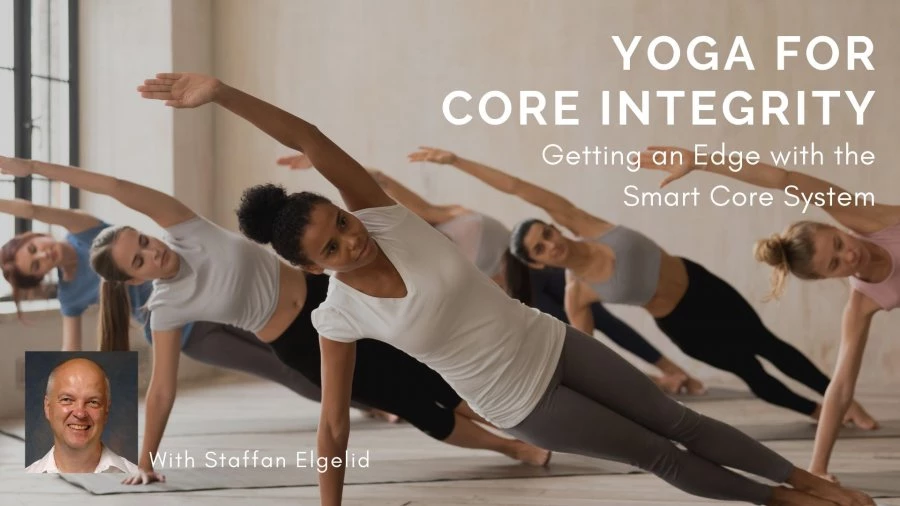Lateral Love: A Gentle Yin Yoga Sequence to Lengthen the Side Body

Yin yoga can be magical. As it works to elongate your connective tissues, it can create space in places you likely didn’t even realize were constricted.
Personally, one of those tight-but-I-didn’t-know-it places was my side body. A great deal of what I had been practicing on my yoga mat was constricted to forward and backward movements. And at work, I was sitting for long periods with little movement at all. I was severely neglecting lateral movements.
Luckily, I found lots of juicy side body stretches in my yin yoga practice to gently lengthen and open this part of my body that I didn’t even realize was so desperate for movement.
The following sequence is something I now practice regularly to keep length and, more importantly, normal mobility in my side body. Plus, due to the inherent nature of yin yoga healthily stressing joints and focusing primarily on the hips and spine, this sequence also offers a lot of bonus benefits beyond simply lengthening the side body!
Practice This Yin Yoga Sequence to Elongate Your Side Body
Grab your mat, a yoga block (or thick book), and a bolster (or big pillow) and prepare to release built-up tension in your side body as you create more space, length, and mobility.
Yin Yoga Seated Side Body Stretch

- Begin by sitting on the floor in any comfortable seat. You may wish to elevate your hips by sitting up onto your block or bolster so that you can relax the weight of your knees down toward the floor.
- Take a moment to lengthen your spine, close your eyes, and connect with your body. Listen to the rhythm of your breath and mentally prepare yourself for your practice.
- When you feel ready, gently flutter open your eyes. Rest your left hand either onto the floor or a prop next to your left hip.
- As you inhale, stretch your right arm toward the sky and lengthen your whole waistline.
- As you exhale, gently side bend toward your left. Root your right sit bone down toward the earth and reach your right fingertips in the opposite direction. Ever so slightly, spiral your heart open toward the sky.
- Either choose to stay as you are or bend your right elbow and rest your right hand behind your head. You may also wish to lower your left elbow to a block and then bend your elbow to rest your head into your left hand for extra support.
- Find a position where you can soften muscular control and then surrender into the shape for about 1 to 2 minutes. When you’re ready, slowly release and repeat on the opposite side.
Low-Flying Dragon Variation
- From your simple seat, remove any props from underneath you. Cross your ankles to roll forward onto all fours in a Tabletop Pose (Bharmanasana).
- Step your right foot forward next to your right thumb. You may choose to stay as you are or scoot your left knee back slightly to intensify the sensations of the lunge. You may also wish to add padding underneath your left knee.
- Lift the weight of your torso and rest both hands on your front thigh.
- Then, place your block near your right hip and rest your right hand on top of it.
- Inhale and lengthen your left arm toward the sky.
- Exhale and side bend toward your right, stretching from your left knee all the way up to your left fingertips. Ever so slightly, spiral your heart to face the sky.
- You can stay as you are or bend your left elbow and rest your left hand behind your head.
- Breathe into the side body (and hip!) and stretch for about 1 to 2 minutes before switching sides.
Yin Yoga Shoelace Variation

- After you’ve practiced Dragon Pose on both sides, return to Tabletop Pose and move your body organically in any way that it craves. You may flow through a few rounds of Cat/Cow Pose (Marjaryasana/Bitilasana) or sit back into Child’s Pose (Balasana). Listen to what your body is asking for.
- When you’re ready, return to a neutral Tabletop Pose and slide your right knee forward between your hands. Scoot your right ankle toward the left side of your mat and then slide your right knee back down in front of your left.
- Slide your left ankle toward the right side of your mat, and then slowly and carefully release your seat toward props between your heels or the floor. (If this causes sensitivity in your knees, you can either straighten your bottom leg or take this same configuration of your legs while lying down on your back.)
- Elongate and lengthen your whole back body. Relax the weight of your hips toward the floor and stretch the crown of your head toward the sky.
- Rest your left hand on a prop or the floor next to your left hip.
- Inhale to lengthen your right arm to the sky and exhale to side bend toward your left.
- Either choose to stay as you are or bend your right elbow and rest your right hand behind your head. You may also wish to lower your left elbow to a block and then bend your elbow and rest your head on your left hand for extra support as you hold.
- As much as you can, soften muscular control and surrender to the release for about 2 minutes. When you’re finished, slowly unwind and switch sides.
Dragonfly Variation

- After you’ve practiced Shoelace on both sides, again return to Tabletop Pose and move your body organically in any way that it is craving.
- When you’re ready, turn to face the long edge of your mat and release your seat to a prop or to the floor.
- Open your legs into a wide V-shape, bending your knees as little or as much as you’d like to get comfortable. You can place props (like rolled-up towels or blankets) underneath your knees as well.
- Place your block on the inside of your right thigh and rest your right hand or elbow onto the block.
- As you inhale, stretch your left arm to the sky and lengthen the left side of your torso. As you exhale, side bend and lean toward your right.
- Again, either choose to stay as you are or bend your left elbow and rest your left hand behind your head. You may also wish to bend your right elbow and rest your head on your right hand for extra support.
- Hold for about 2 minutes, and then switch to the other side.
Yin Yoga Deer Pose

- Once you’ve lengthened your side body on both sides in Dragonfly, slowly bend your knees and draw your legs back toward the midline of your mat. Keep your feet a little bit wider than hips-distance apart.
- Remove any props from under your seat and stay in the middle of your mat, facing toward the long edge.
- Release your hands behind your hips and slowly lower both knees toward your right so that your right shin lands roughly parallel to the short top edge of your mat.
- Place your right fingertips behind your right hip and rest your left hand on your right knee.
- With an inhalation, elongate and lengthen your whole spine. With an exhalation, spiral and twist your torso toward your right.
- Place your bolster or pillow lengthwise behind you so that it is parallel with the long edge of your mat. You may wish to raise the height of your bolster or pillow by placing a block or another pillow underneath it.
- Slowly and mindfully release the weight of your torso onto your prop and rest one cheek onto it. You can either lie directly onto your right shoulder over the bolster or let both of your hands frame your bolster for a deeper twist.
- Either choose to stay as you are or stretch your left hand to rest on the floor above your head for a more intense side body release.
- Wherever you choose to be, surrender into the shape for about 2 to 3 minutes and then unwind and practice the same steps on the other side.
Bananasana

- After Deer Pose, move all of your props toward the side of your mat and come to lie down flat on your back.
- Stretch your arms up above your head and hold onto your left wrist with your right fingertips.
- Keep your hips where they are, and slide your feet toward the right side of your mat. Either keep your legs like this or cross your right ankle over your left to act as an anchor.
- Again maintain your hips as they are and slide your arms and your torso toward the right side of your mat. You can keep your grip around your left wrist or if your arms start to get tingly or numb, then release them down in line with your shoulders or by your sides.
- Elongate the whole lateral side of your body from your fingertips all the way down to your toes.
- Stay and hold for about 3 to 4 minutes and, when you’re ready, slowly release and return back to neutral for a moment to “reset.” When it feels appropriate, practice all of the same steps on the other side.
Relaxation Pose (Savasana)

- After you’ve finished Bananasana, return to a neutral savasana (lying flat on your back).
- Take any final movements that your body is craving. You may wish to slide your bolster or pillow underneath your knees to give your lower back some extra support.
- When you feel ready, close your eyes and completely relax and release to surrender into your final resting pose, Savasana.
- Allow yourself to feel the length you’ve created in your side body and soften into this newfound space.
- Stay for as long as it benefits you, and when you’re ready to move on with your day, slowly and mindfully resurface with a new appreciation for your side body.
Are you interested in more anatomy and yoga practice tips? Read Leah Sugerman’s article Yoga Anatomy 101: Stop Relaxing Your Glutes in Backbends.
Study core strength with YogaUOnline and Staffan Elgelid – Yoga For Core Integrity: Getting An Edge With The Smart Core System
Also, read...
In Celebration of Gray-Haired Yoga – Busting the Myth of the Yoga Body
Stand Firm: 6 Easy Balancing Moves for Your Daily Yoga Routine
Related courses

Leah Sugerman is a yoga teacher, writer, and passionate world traveler. An eternally grateful student, she has trained in countless schools and traditions of the practice. She teaches a fusion of the styles she has studied with a strong emphasis on breath, alignment, and anatomical integrity. Leah teaches workshops, retreats, and trainings, both internationally and online. For more information, visit www.leahsugerman.com.





